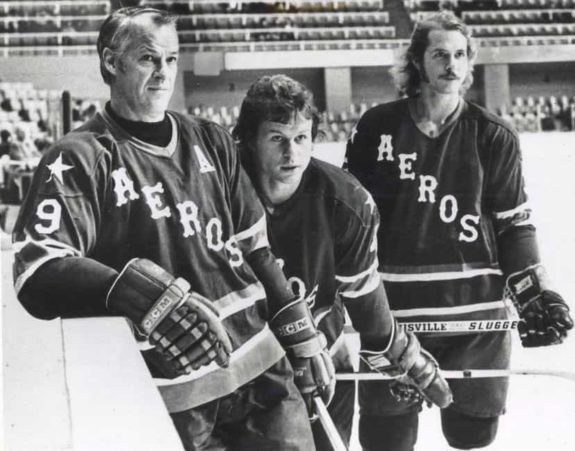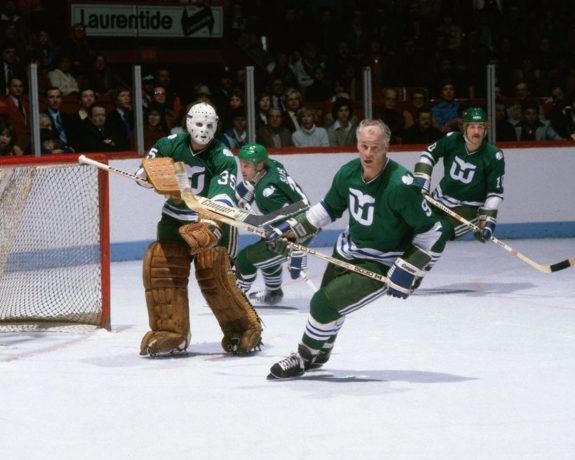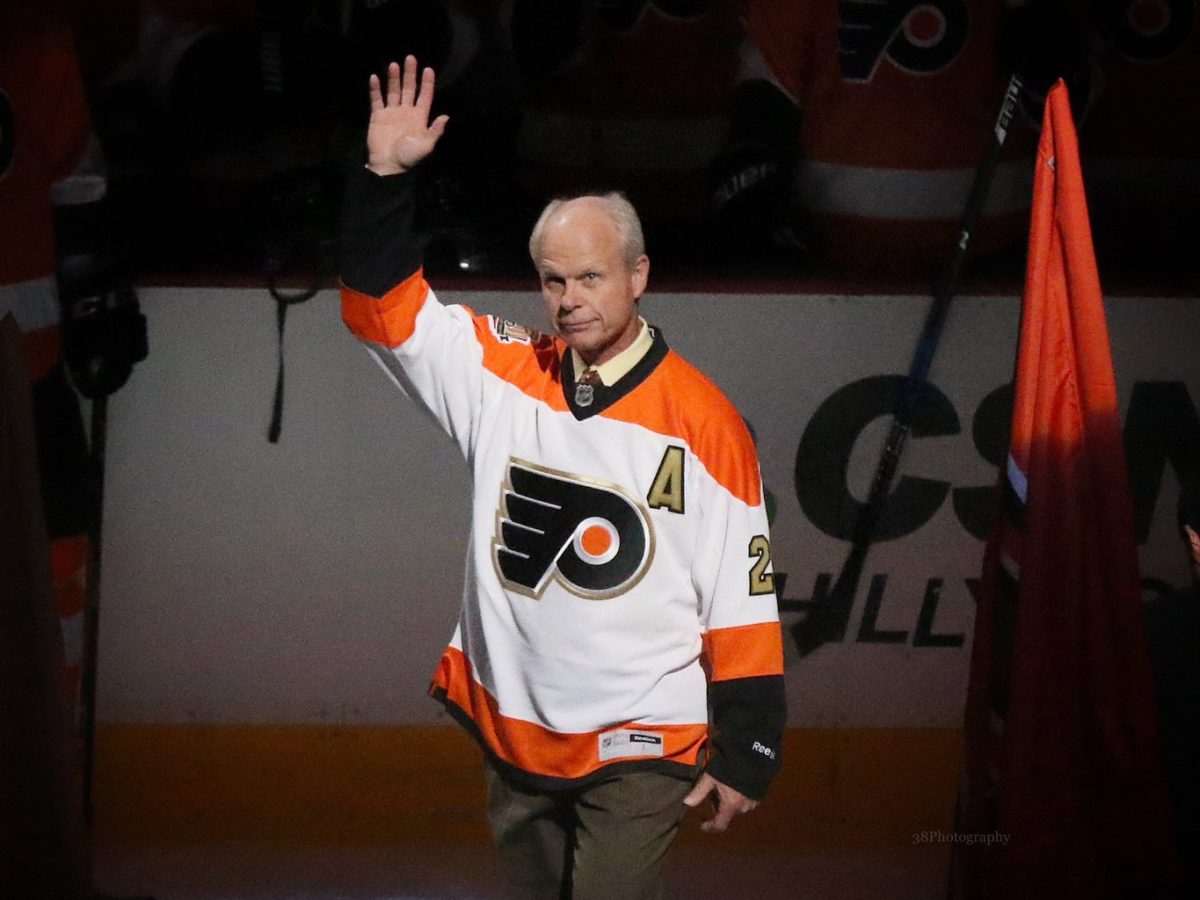Mark Howe is statistically the best defenseman in the history of the Philadelphia Flyers. His No. 2 was retired by the organization in 2012 and he was inducted into the Hockey Hall of Fame in 2011. However, if a series of events had not occurred, there is a chance Howe may never have set a precedent for defensemen for the Orange and Black.
Son of Hockey Royalty
Mark is one of the sons of fellow Hall of Famer Gordie Howe. He actually broke out on the pro hockey scene alongside Gordie and Mark’s brother Marty. The three played together on the Houston Aeros in the World Hockey Association (WHA) during a good portion of the 1970s. Eventually, the family left Houston and went to play for the WHA’s New England Whalers. All during this time, Mark put up significant numbers for his teams:
- 1973-74 (Aeros): 38 goals and 41 assists for 79 points in 76 games
- 1974-75 (Aeros): 36 goals and 40 assists for 76 points in 74 games
- 1975-76 (Aeros): 39 goals and 37 assists for 76 points in 72 games
- 1976-77 (Aeros): 23 goals and 52 assists for 75 points in 57 games
- 1977-78 (Whalers): 30 goals and 61 assists for 91 points in 70 games
- 1978-79: (Whalers): 42 goals and 65 assists for 107 points in 77 games
While with the Aeros, Mark switched positions from winger to defenseman. It was a move that he was put into by coach Bill Dineen. There were injuries and Howe needed to fill the role. That move became a staple in the rest of his professional career.

After having quite a bit of success professionally, Howe had a big setback while playing for the Hartford Whalers (they were renamed when the franchise joined the NHL) that required a lot of hard work and perseverance. It changed the course of Mark’s pro hockey journey and had an impact on the league as a whole.
Infamous Injury and Fallout
The beginning of the end for Howe in Hartford occurred during the 1980-81 season. Mark, during a game against the New York Islanders, crashed into the net and punctured his rectal area. It was a really gruesome injury, and Mark went to the hospital. He discussed what happened with Mark Malinowski of The Hockey News:
“I was playing in Hartford and I got skewered on the net…The center point of the net pierced my rectal area and went in about five to five-and-a-half inches and actually had cut out on the other side. So I actually kind of had a hole almost all the way through my body,” Howe said in his interview with Malinowski. This was back during the days when the nets had a sharp middle part that stuck out.
You may also like:
- Blue Jackets Unable to Hold Third Period Lead in Loss to Flyers
- Projected Lineups for the Blue Jackets vs Flyers – 12/21/24
- Flyers Gash Playoff Hopes by Demoting Emil Andrae
- NHL Rumors: Predators, Canadiens, Flyers, Sharks, Maple Leafs
- LA Kings Game Notes: Annihilate Flyers With 7-3 Thumping
Mark talked about how bad things could have been.
“Yeah, so if you look at it in hindsight, I am very fortunate I’m still able to walk…I lost five pints of blood and was pretty well in bed for four weeks because I ended up with a really bad infection…Shock set in. Some of the pain goes away, but it was very, very fearful. I remember laying on the ice and I knew kind of what had happened. And my instincts were, I thought I was going to die,” Howe explained to Malinowski.
The injury took a toll on Mark. He talked about this injury as well to Craig Custance, who was with ESPN. It was a tough road to get better for Howe.
Custance’s article reads, “There was an infection, fevers and medication that made it impossible for Mark to leave his hospital bed. His appetite was completely gone. After he had spent days in bed, doctors warned Mark that he needed to get up and walk. Every time he tried, he got sick.” Mark told Custance that his father Gordie made him walk around regardless of the nausea. The article continues, “He says ‘Do what you gotta do. You’re going to walk,'” Mark remembered Gordie saying. “I threw up all over him as he walked me around the room.”

The aftermath of the injury was rough in the beginning. Howe sued the NHL so that the league would change the structure of their nets, to which the nets became what hockey fans know of today. Howe, though, never really was the same player again with the Whalers. As was mentioned by Custance in his ESPN piece, “Howe spent a month in and out of hospitals and returned to play 20 pounds lighter. He missed just six weeks, but his game took much longer to return.”
Howe fought back during the offseason to get into hockey shape for the following campaign, trying to restore his body to the way it was before the injury. He was still not 100% though when he went back to training with the Whalers, and management started to develop opinions on him.
Whalers’ general manager Larry Pleau thought that Mark was not as motivated to come back to play hockey given his financial stability, and also tabbed him as a complainer. Mark received word of this, confronted Pleau and had a conversation with him, and gave him a list of a few teams to be traded to. As a result, he was eventually dealt to the Flyers. The full trade was Howe and a third-round pick in 1983 to Philadelphia for winger Greg Adams, forward Ken Linseman, a first-round pick, and a third-round pick (both in 1983).
Becoming a Top Flyer Defender
The move to the City of Brotherly Love was the change Howe needed. He became a core member of Philadelphia’s blue line for 10 seasons.

He skated with some other solid defenders during his time such as Brad Marsh and Doug Crossman, but Howe became the face of the backend for them. He posted the following numbers while with the Orange and Black:
- 1982-83: 20 goals and 47 assists for 67 points in 76 games
- 1983-84: 19 goals and 34 assists for 53 points in 71 games
- 1984-85: 18 goals and 39 assists for 57 points in 73 games
- 1986-87: 15 goals and 43 assists for 58 points in 69 games
- 1987-88: 19 goals and 43 assists for 62 points in 75 games
- 1988-89: 9 goals and 29 assists for 38 points in 52 games
- 1989-90: 7 goals and 21 assists for 28 points in 40 games
- 1990-91: 10 assists in 19 games
- 1991-92: 7 goals and 18 assists for 25 points in 42 games
Howe made three All-Star appearances for Philadelphia (1983, 1986, and 1988). He also was a factor in the Flyers making the Stanley Cup Final in 1985 and 1987. They faced Wayne Gretzky and the Edmonton Oilers in both of those Cup Finals. In the 1985 postseason, Howe posted three goals and eight assists for 11 points in 19 games. As for 1987, he accumulated two goals and 10 assists for 12 points in 26 games. Unfortunately for him and the Flyers in both series, the Oilers won the Cup. Howe was a solid asset throughout this entire time for Philly though.

Mark left the Flyers as a free agent in 1992 and inked a contract with the Detroit Red Wings, an organization that knew his family all too well already. He played in the Motor City until 1995, making it to the Stanley Cup Final with them in 1995 and losing to the New Jersey Devils. Howe then retired.
When hockey fans think of the contributions of Mark, many picture him as a member of the Flyers. His time in Philly really defined his Hall of Fame career. If circumstances had been a bit different for him in Hartford, his Flyer tenure may never happen. His NHL journey is a story of not giving up when the odds are stacked against a person. It may not be easy, but if someone puts in the work and does all the right things, difficult obstacles can be overcome. He put in the work and became a legend based on what he was able to accomplish.